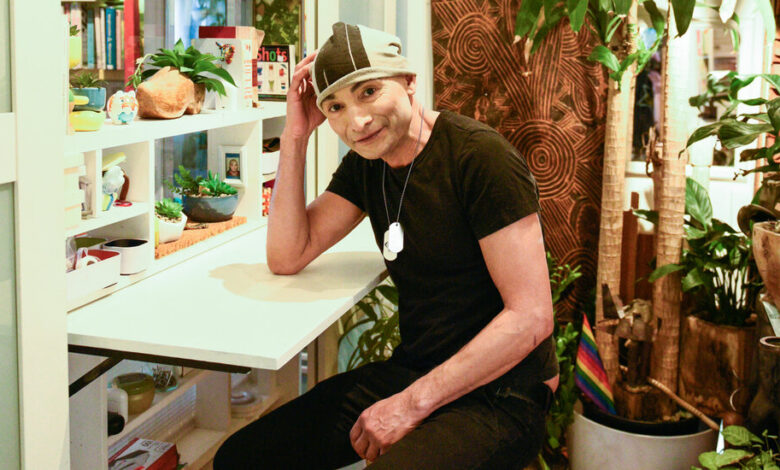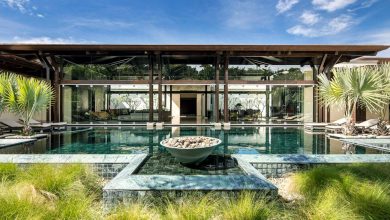How Do You Fit 250 Plants in 350 Square Feet?

[ad_1]
If you visit Alejandro Aguilar’s Brooklyn home in early spring, the best time to show up is between 6:30 and 7 p.m. That golden half-hour is when sunlight skims over the surrounding factory buildings and streams through the windows, kissing the leaves, fronds and spines of his 250-odd houseplants.
You’ll find a white moth orchid posted at his doorway like a member of the King’s Guard, and a cohort, beyond that, of snake plants and spider plants in little pots. Pothos dangle from beams like paratroopers; villages of cactuses are arranged in dusty clusters; and aloe vera plants spike the windowsills. In one corner, a corn plant towers over baskets of bromeliads and ferns.
Mr. Aguilar is vastly outnumbered by his greenery. It is a wonder that he has room to move around at all. The second-floor apartment, which is in a century-old brick townhouse in East Williamsburg, is only 350 square feet. But Mr. Aguilar, 60, is an interior designer who has made a career out of maximizing space in tiny homes.
He has skillfully arranged this one to feel like anything but a damp, loamy conservatory. Your first instinct is not to say, “Lordy, that’s a lot of plants,” but to marvel at the many moods, nooks and vignettes in what began as a simple square.
Mr. Aguilar, who was born in Honduras and has lived in New York for half a century, continues to embrace the lifestyle of a young urban newcomer, settling down in fringy neighborhoods until he is chased away by rising rents. He moved to this building in 2012 after eight years in North Williamsburg and has taken three and a half years to complete this renovation — more or less.
“I’m waiting for the bathroom ceiling to collapse one more time,” he said, at which point he can supervise the landlord’s replacement of it.
And although the ax of gentrification has fallen on East Williamsburg, it is challenging to be woken at 5 a.m. by the warning beeps of freight trucks thrown into reverse gear, he said. People are not rushing to move into his building. His rent is still only $1,350 a month.
“This is Japanese living at its best,” he said.
And his tiny domicile is palatial when you compare it to the 184 square feet he once occupied comfortably on the Lower East Side. Through an ingenious use of mirrors, sliding-glass doors, curtains and customized storage, he has managed to carve out no fewer than six distinct spaces within the apartment.
First is the entrance, which has a mirrored ceiling and a wall papered with a fragment of a botanical pattern called Scandinavian Bellewood. Translucent white, gridded fabric covers the opening of an overhead storage compartment. (The textile, which Mr. Aguilar picked up at a fabric store in Downtown Brooklyn for $1.99 a yard, reappears many times at many lengths throughout his home.)
The next room is a white, multipurpose space that shows off the unit’s original wood floors and pressed-tin ceilings. Mr. Aguilar added beams that incorporate tracks for sliding-glass partitions and provide handy surfaces for plants and artifacts.
“I hate going into a kitchen right away” after entering a home, he said, so he tucked his refrigerator, sink and miniature bar into an ell that can be closed off (Space No. 3), and built a tall, narrow pantry as the room’s central feature. Its open shelves hold glass jars, fruit bowls and greenery. The lowest shelf thrusts out to serve as a table, with a couple of stools stored underneath.
Turning right from the entrance takes you to Space No. 4: a strip that is Mr. Aguilar’s office and shrine. He designed and built the slim, fold-down desk and shelving. (At this juncture, it should be noted that there is hardly an aspect of the renovation that he didn’t nail, paint, glue or sew with his own hands.) Anchored by the corn plant, the shrine also includes pink Himalayan salt lamps, a Santeria statue and a large wooden sculpture shaped like a penis (a gift from an artist friend).
But all of this is just a prelude to Space No. 5, which Mr. Aguilar reveals with a flourish, sliding open another set of glass doors in the pantry/dining room and pulling back gossamer curtains like a magician’s assistant.
What appears is a room less than eight feet wide with a maroon-painted tin ceiling, the color flowing a dozen inches down dark gray walls. Its cheerful-looking plants bask in light from a south-facing window. Its bookcases are cobbled together from Ikea plumbing tubes and plastic brackets. Its dusty rose daybed is Scandinavian.
“I use mirrors a lot, as you can see,” Mr. Aguilar said, indicating one silvery wall. He made a panel out of nine mirrors that he found on the cheap and glued strips of stained wood to their surfaces to form a jazzy grid pattern. Because it is not easy to live in constant sight of one’s own reflection, he said, he modified the mirrors further by cracking the glass.
And those paintings? he is asked about a pair of abstract canvases on the opposite wall.
“Those are actually fire-retardant panels I found on the street,” he said. “And one day I was painting on them.” The outlines of the sprayed objects with their neon halos led him to exclaim, “Oh, my God, this looks like art!”
And he sleeps where?
Mr. Aguilar leads his visitor to Space No. 6.
This pale blue room, off the study, has no obvious bed, but it does have a floor covered in soft mats and a pair of rings dangling from the ceiling for exercise. Handmade bookshelves painted in a mix of splashy colors are crammed with potted plants and art objects. Framed pictures stand five- and six-deep on the floor below.
“Everywhere you sit there’s always something to look at, from every angle,” Mr. Aguilar said, and then shooed his visitor from the room.
When the visitor was summoned back, the bed had appeared, having been lowered from its disguised vertical position fronting another set of bookcases at the room’s entrance.
“I’m an intense guy, and kind of too much sometimes,” Mr. Aguilar said after the tour was over.
His clients seem to adore him, nonetheless.
Raphaele de Boisblanc, the director of marketing at the Brooklyn Academy of Music, met Mr. Aguilar seven years ago when she and her husband, Peter de Boisblanc, moved with their two young children into a brownstone in Carroll Gardens, Brooklyn. Their floor-through coop had two bedrooms and one bathroom, and the couple appealed to Mr. Aguilar to help them make efficient use of the space.
Ms. de Boisblanc, 47, who is French, recounted Mr. Aguilar’s first observation in a recent phone interview: “Spaces are not the issue; people are,” he told her.
Before entering a working relationship, he insisted on spending time with the family over multiple days to observe how they lived. “He said it was important that we felt comfortable around him, because it would be a process,” she said.
The feeling cut both ways. “I don’t like to work with people I don’t like,” Mr. Aguilar told her.
The designer does not have what one might call a head for business. He is not a great believer in contracts. He consults with his clients for free, spouting suggestions for improvements that they can take or leave. Rather than using computer software to render a design concept in a realistic way, he sometimes simply executes his ideas so that his clients can visualize what he had in mind, undoing the work if they are not enchanted.
That’s how Quincey Smith, 33, came home one day to his one-bedroom apartment in Crown Heights, Brooklyn, to find that Mr. Aguilar had rearranged the furniture and demarcated areas in the living room by painting the columns.
Mr. Smith, who works in external affairs and crisis management for an international organization, was not put off. Although he found the absence of any formal work agreement disorienting at first, he learned to trust Mr. Aguilar and enjoyed the many (unbilled) hours in his company discussing color and studying the changing light in his home. “It’s clear that he cares so much about design, about the energy in a space,” he said.
Mr. Aguilar’s clients also described being awed at his resourcefulness, born of what appears to be an exhaustive knowledge of the inventory of every hardware store and housewares supplier in the New York metropolitan area.
“One of the great joys is going to Ikea with Alejandro,” said Phoebe Holtzman, 34, who with her husband, Massimo Young, hired Mr. Aguilar to work on several projects in their brownstone in Bedford-Stuyvesant, Brooklyn. “Not only does he exactly know what is good quality and what isn’t, but he knows where everything is, all the little back hallways.”
Jarema Osofsky, 37, who hired Mr. Aguilar to build out her business in Gowanus, Brooklyn, an interior plant design and landscape design studio called Dirt Queen NYC, recalled how he created bamboo mobiles inspired by Alexander Calder sculptures. “He’s a wizard with small spaces,” she said.
“He is a … how do you say…?” Ms. de Boisblanc turned away from the phone to speak French to her family. “Oh yes,” she came back. “An elf. But a magical one, not a nasty one.”
Living Small is a biweekly column exploring what it takes to lead a simpler, more sustainable or more compact life.
For weekly email updates on residential real estate news, sign up here.
[ad_2]
Source link






